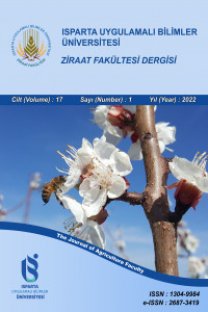Karabuğday (Fagopyrum esculentum Moench)’ın Verim ve Mineral Besin İçeriği: Hasat Zamanının Etkisi
Karabuğday (Fagopyrum esculentum Moench)’ın temel yetiştirme amacı, insan beslenmesinde özellikle glütene hassas ve hipertansiyon hastalığı olan insanların beslenmesi için tane elde etmektir. Bu çalışma karabuğdayın verim, farklı hasat zamanlarında bitkide, bitki organlarında ve tanesinde mineral besin içeriğini araştırmak amacıyla 2012 ve 2013 yıllarında yürütülmüştür. Araştırmada Güneş karabuğday çeşidi kullanılmıştır. Karabuğdayın verim ve mineral besin içeriği bitki organlarına ve hasat zamanlarına göre değişmiştir. Karabuğdayın taze ve kuru ot verimi, farklı bitki organlarında ve hasat zamanlarında mineral besin içeriği istatistiksel olarak (p< 0.01) önemli olmuştur. Tane verimi 2012’de 146.08 kg/da ve 2013’de 159.26 kg/da olarak elde edilmiştir. Tanenin mineral besin içeriği her iki yılda da birbirine yakın çıkmıştır. Hasat zamanları karşılaştırıldığında, her iki yılda da en yüksek yeşil ot (sırasıyla, 2739.33 ve 2760.31 kg/da) ve kuru ot (766.13 ve 853.67 kg/da, sırasıyla) verimi 5. hasat zamanından (en son hasat zamanı), en düşük yeşil ve kuru ot verimi ilk hasat zamanından elde edilmiştir. Taze ve kuru ot verimi hasat zamanının gecikmesiyle artmıştır. Her iki yılda da çinko dışında, en yüksek mineral besin içeriği 2. hasat zamanında belirlenmiş, en düşük besin içeriği ise hasat zamanlarına göre değişmişti. Bitki organları karşılaştırıldığında, her iki yılda da en yüksek taze ot (sırasıyla 463.84 ve 497.57 kg/da) ve kuru ot (sırasıyla, 161.62 ve 168.3 kg/da) verimi sapta belirlenirken, en düşük taze ve kuru ot verimi çiçekten elde edilmiştir. Her iki yılda da en yüksek mineral besin içeriği yaprak ve çiçekten, en düşük mineral besin içeriği ise (K hariç) saptan elde edilmiştir.
Anahtar Kelimeler:
Karabuğday, mineral besin, tane verimi, taze ve kuru ot verimi
Yield and Mineral Nutrition Content of Buckwheat (Fagopyrum esculentum Moench): The Effect of Harvest Times
Buckwheat (Fagopyrum esculentum Moench) is cultivated primarily to obtain grains for human consumption, especially gluten sensitive patients and hypertensive people. The present study was conducted to investigate the yield and mineral nutrient contents in plant organs, the harvest times and grain of buckwheat in 2012 and 2013. The Güneş species were used as the buckwheat cultivar. The results revealed that the yield and mineral nutrient content of buckwheat varied according to both plant organs and harvest times. The herbage-hay yields and mineral nutrient contents in plant organs and harvest times of buckwheat were statistically (p< 0.01) significant in both years. A mean grain yield of 1460.8 kg ha-1 was obtained in 2012 and 1592.6 kg ha-1 in 2013. The mean seed mineral nutrient contents of both years were found to be very close to each other. At harvest times, the highest herbage (27393.3 and 27603.1 kg ha-1, respectively) and hay yield (7661.3 and 8536.7 kg ha-1 , respectively) were determined at the 5th harvest time (the latest harvest time), the lowest herbage and hay yield was obtained from the first harvest time in both 2012 and 2013. The herbage and hay yields increased by delaying harvest times. The highest mineral nutrition contents, except for Zn, were determined in the second harvest time. The lowest mineral nutrition contents varied according to the harvest times in both years. In comparison with different plant parts, the highest herbage (4638.4 and 4975.7 kg ha-1, respectively) and hay yield (1616.2 and 1684.3 kg ha-1, respectively) were determined in the stem, while the lowest herbage and hay yields were obtained from flower organs in both 2012 and 2013. The highest mineral nutrition contents were obtained from the leaf and flower organs whereas the lowest mineral nutrition contents, except for K, were determined in the stem in both years.
Keywords:
Buckwheat, mineral nutrient, grain yield, herbage and hay yield,
- ISSN: 1304-9984
- Yayın Aralığı: Yılda 2 Sayı
- Başlangıç: 2006
- Yayıncı: Isparta Uygulamalı Bilimler Üniversitesi
Sayıdaki Diğer Makaleler
Ananasın Mikrodalga ile Kurutulması ve Uygun Kuruma Modelinin Belirlenmesi
Bazı Tritikale Genotiplerinin Batı Geçit Bölgesinde Verim ve Verim Unsurlarının Belirlenmesi
Karabuğday (Fagopyrum esculentum Moench)’ın Verim ve Mineral Besin İçeriği: Hasat Zamanının Etkisi
MELEKBER SÜLÜŞOĞLU DURUL, AYSUN ÇAVUŞOĞLU
ULUKAN BÜYÜKARIKAN, MEVLÜT GÜL
Çukurova Bölgesinde Kükürt Kaynak ve Dozlarının Pamuk Verimine Etkisi
